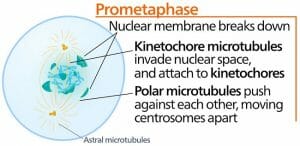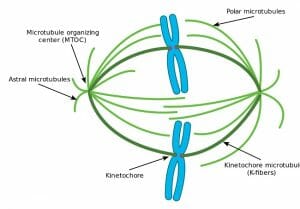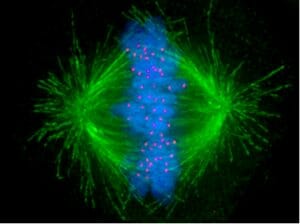Prometaphase Definition
Prometaphase is the stage of eukaryotic cell division that falls between prophase and metaphase. During prophase, the cell’s chromosomes have condensed and the cell’s centrosome, or microtubule organizing center, has divided and moved to opposite sides of the cell. During prometaphase, several key steps take place, including the breakdown of the nuclear envelope and the attachment of microtubules to each of the chromosomes.
Although the breakdown of the nuclear membrane is not clearly understood, it is known that the membrane breaks apart during prometaphase. The nuclear membrane is made of two lipid bilayers, with many pores that allow ribosomes to pass through membrane. At the onset of prometaphase, proteins are released that remove specific molecules from the nuclear membranes. Without the molecule, the membranes fall apart. They will be reassembled during telophase before the cell is fully divided into two new cells.
The breakdown of the nuclear membrane allows the attachment of microtubules to the chromosomes. Chromosomes have special regions associated with proteins that allow sister chromatids to attach to each other. These regions are known as centromeres. The centromere of each chromosome contains other specialized areas, called kinetochores, which allow the attachment of microtubules. Originating in the centrosome on each end of the cell, the microtubules form a matrix throughout the cell known as the spindle apparatus.
The spindle apparatus contains several types of microtubules, as seen in the graphic below. The kinetochore microtubule find their way to every chromosome, from each side. Motor proteins can move substances along the microtubules. Also, the microtubule organizing center, or centrosome, can add or remove monomers of the microtubule, increasing or decreasing its overall length. This can push and pull the chromosomes towards the metaphase plate for the next stage in eukaryotic cell division.
During prometaphase of mitosis, the mitotic spindle is formed, and the two halves of each duplicated chromosome are aligned on the metaphase plate. These sister chromatids will be divided during anaphase, because the proteins that hold them together at the centromere will be released. In meiosis, the stage of prometaphase is usually broken into the late parts of prophase or the early parts of metaphase, but the processes of prometaphase must still happen. In the first division of meiosis, however, the meiotic spindle is created, which aligns homologous chromosomes on the metaphase plate.
Prometaphase has a checkpoint, the spindle checkpoint, which will not allow the cell to move to the next stage of cell division. This checkpoint relies on all chromosomes being attached to the spindle. This ensures that cell division does not proceed without the proper division of chromosomes. This can happen, and is the known cause of some birth defects. Down Syndrome, for example, is causes by the spindle checkpoint being missed, and an extra copy of chromosome 21 being transferred to a single gamete. When this gamete gets fertilized by another gamete, three copies of chromosome 21 are present, which leads to developmental abnormalities.
The following is a picture of a cell during late prometaphase. The bright colors in the photograph have been created by fluorescent molecules that attach to various structures. The green lines are the spindle fibers, or microtubules. The red dots represent individual kinetochores. The blue is created by fluorescent molecules attached to the DNA. The bright green lines are kinetochore microtubules, and prometaphase will continue until all of the red kinetochores are attached to microtubules.
Related Terms
- Nuclear envelope – The double phospholipid bilayer (4 layers) that surrounds the nucleus of eukaryotes.
- Kinetochore – Special structures within the centromere of chromosomes that allow spindle fibers to attach.
- Centromere – Regions within chromosomes that associate with special proteins to be moved by microtubules and to attach sister chromatids.
- Centrosome – The microtubule organizing center in cells, capable of producing and removing microtubules.
Quiz
1. In plants, no centrosomes are present. In fungi, the nuclear envelope does not break down. Does prometaphase take place in these organisms?
A. Only in the Fungi
B. Yes, in both
C. No
2. What happens to the nuclear envelope after it falls apart?
A. It is destroyed.
B. It is reassembled around each new nucleus.
C. We have no idea.
3. In prokaryotes, there are no internal organelles, but internal components must still be separated. Which parts of prometaphase must take place in bacteria?
A. None of the parts
B. Spindle formation
C. Spindle formation and nuclear envelope degradation



